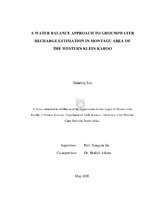| dc.description.abstract | The Western Klein Karoo-Montagu area is located in the mid-eastern of the Western Cape Province , South Africa. In most of the study areas within semi-arid climatic zone , groundwater plays an important role in meeting both agricultural and urban water requirements. Developments of agriculture depend on more and more groundwater
supply from Table Mountain Group (TMG) sandstone aquifer system in the study area. Groundwater recharge is considered as one of the most important factors governing the
sustainable yield of groundw ater exploitation. There have been few studies on the recharge estimation of the TMG aquifer system in the Montagu area. Thus accurate and
reliable recharge estimation of the TMG aquifer system in the Montagu area is important. The TMG aquifer in the Montagu area comprises approximate 4,000m thick sequence of sandstone with an outcrop area of 3,124 km2, which is recharge area. The outcrops are characterized by mountainous topography with sparse to dense vegetation,
shallow and intermittent diverse soils and mean annual rainfall of 350-450 mm/yr. Based on detail analysis and interpretation of factors influencing recharge, water balance method is used to estimate recharge rates by using readily available data (rainfall, runoff, temperatures). Other estimate methods are difficult to be applied due to the limited information available in the study area. In this study, the water balance approach based on empirical evapotranspiration and runoff model is employed to
determine and analyse long-term average water recharge. The long-term average recharge is modelled as a function of the regional interaction of the site conditions: climate, soil, geology and topography. Modelling is performed according to the outlined procedure using long-term climatic and physical data from the different rainfall period of different gauge stations. As results, actual evapotranspiration, direct
runoff and recharge have been quantified. The recharge ranges vary from 0.1 mm/yr to 38.0 mm/yr in the study area, and the values less than 20.0 mm/yr are predominant.
Relatively low recharge rates coincide with low precipitation in most regions. Recharge is less than 5.0 mm/yr if mean annual precipitation (MAP) is less than 400 mm/yr. The
ranges of 10.0-20.0 mm/yr of recharge occur in precipitation ranging from 600 mm/yr to 1,200 mm/yr. The recharge rates exceeding 20.0 mm/yr are more related to the precipitation with 800 mm/yr or more. The low recharge rates less than 2.0 mm/yr are related to single high rainfall event in the study area. The total recharge volume of the outcrop of the TMG in the study area is approximately 54.2× 106m3/yr . Approximately 29.3% of the stream flow may be contributed by recharge in terms of baseflow. The recharge in the study area increases with increasing precipitation, but recharge
percentage is non-linear relationship with the precipitation. Separate high rainfall events mainly contribute recharge if annual precipitation is extremely low in the study area. Spatial distribution of recharge is associated with the variations in precipitation, geological and geomorphologic settings in the study area. The method used yields a point estimate and then ext rapolate s to the whole study area.
The ranges of recharge may be exaggerated or underestimated due to the finite number of the rainfall stations in the outcrop of the TMG of the study area. After comparison to other recharge estimates from early studies in the area, the estimates are considered as reasonable and reliable. The feasibility of the water balance approach in semi-arid area is confirmed as well. The estimates based on the water balance model should be crosschecked before they are applied for management of groundwater resources. | en_US |

